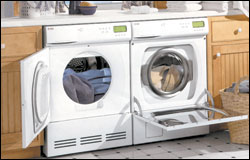ENERGY STAR LABELING sure sounds like a good idea. Here’s the pitch: Design a program to raise awareness about buying energy-efficient appliances. Start with a cute little logo that conjures up images of clean, green, eco-friendly living, and put it on products that meet efficiency standards set by the government. Then, let the free market do its thing. If the Star appeals to consumers, every new model of appliances, electronics, or computers will earn the Energy Star in a few short years.
That’s exactly what the Environmental Protection Agency did in 1992, and boy, did it catch on. At first, only computers and monitors were assessed; now, Energy Star extends to over 30 categories, from windows to refrigerators to TVs and DVD players. There are even Energy Star-approved homes. And sure enough, just about every new model in just about every product category reviewed by Energy Star now carries the ubiquitous labelwhich is the very problem with Energy Star.
Say you want to feel like you’re doing your part every time you turn on the tube, so you’re looking for the most energy- efficient idiot box on the market. How on this polluted Earth can you know what to buy if every model has the Energy Star imprimatur? Well, I’ve got bad news: There’s no hands-down winner among those TVs carrying the Energy Star tag. And to make things even more complicated for you green buyers, there’s often no significant difference between Energy Star models and their unstickered counterparts.
Why not? Partly because Energy Star now assesses products in categories that some may consider, well, silly. For example, Energy Star answering machines and portable phones use one-third less power than those without the label. Sounds good, right? But these products use so little energy in the first place that any savings may amount to about 50 cents on your monthly electricity bill. Energy Star TVs, VCRs, and stereos actually use the same amount of power as their counterparts without the Starwhen turned on. The difference lies in that small amount of electricity consumed when these devices are turned off. And as for refrigeratorsthe biggest energy drain on homes not equipped with central air conditioningbuying an Energy Star model will save a whopping $5 worth of electricity per year, according to appliance experts I spoke to. All that might add up over a lifetime (your lifetime), but it’s not exactly saving the Earth especially when that Earth is overrun with SUVs.
There is, however, one huge exception, and that is the clothes washer. Allan Weiskind of Weiskind’s Appliances in North Seattle explains that Energy Star washers use less power and at most half the water of traditional washers (18 to 25 gallons compared to about 40 to 50 per load). They spin clothes faster, which gets them cleaner during the wash cycle and drier during the drying cycle. That last point is particularly important: Dryers use so much electricity that the Energy Star program doesn’t even bother to rate them, so a washing machine with a powerful drying cycle can mean significant savings when the clothes go into the dryer.
The price difference, however, might still give you pause. For example, the sturdy Swedish Asko washer/dryer set is made to last about two decades. It’s compact, stackable, runs on very little electricity, and uses as few as 6 gallons of water per load. Yet the $2,500 price, more than double the cost of some sets, might take those same two decades to pay for itself in savings.
As the federal standards by which the Energy Star is awarded continue to rise, thereby pressuring the industry to improve appliance efficiency, the Star’s work is far from through. The only real danger may be that after buying starred products, people will feel content that they’ve done their part. But old-fashioned awareness is still important. For instance, when it comes to computers and many appliances, Energy Star standards only require that the model have a power-saving option; it’s up to the consumer to find and use it. Stringing up a clothesline, unplugging electronics and computers instead of just turning them off, replacing that 10-year-old refrigerator with a new modelall these behaviors at home can have at least as much impact as what you buy at Sears.





